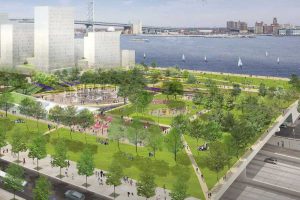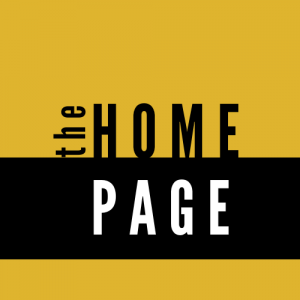An Alternative Narrative
The Side Unseen’s Epilogue
Conversations with my interlocutors have given me insight into their narratives of activism and the solutions they are striving to create in their communities; I’ve also, through extrapolation, gained a greater understanding of what a future in Philadelphia could look like, both physically and relationally, if society gave structural violence consideration. This page’s function is to articulate to the reader that a “utopian” Philadelphia could be created if society could alter its social construction of health to amend the damage caused by structural violence. This fictional account of Philadelphia represents a potential future for Philadelphia; it is written through my interpretations of my interlocutors’ stories combined with their explicitly articulated future imaginations.
* * *
It’s a Monday morning, and Roz is walking to the Prevention Point meal site. Her walk intersects with her cousin Louis, who is on his way to his morning work shift with the help of the newly opened Safehouse and community support. His support system at Safehouse enables him to use drugs in a sterile environment and only to sustain his body’s dependence; he is a fully functioning member of society, makes a livable wage, and has signed a lease on an affordable apartment with Prevention Point’s help. Roz no longer needs to worry about his health status and the dangers of living on the street in Kensington, and so her stress burdens have also significantly decreased. Because Sunshines in Kensington realize that there is a significant support structure available for them if they choose to engage, many more individuals accept Safehouse’s assistance than previous city-sponsored support programs. This is because society no longer chastises drug use, but recognizes the behavior/disorder as an impact of structural violence. Sunshines need to be uplifted and supported- when this occurs, all of society benefits.
Through collaboration with neighborhoods and communities impacted by violent aspects of infrastructure, the city of Philadelphia is redefining the highway system through design. It is the city’s effort to recognize the violent practices of urban design historically present in Philadelphia. Rather than producing elevated roads and trains, all efforts are put towards placing them underground or at ground level. Parks like the “cap” proposed to cover the Penn’s Landing section of I-95 would be a standard of design and would function to reconnect the Riverward communities to the Delaware River (which fueled the area’s historic rise). Fresh grass and dirt alongside brand-new outdoor recreational equipment would be utilized in these parks. These community amenities would provide an uncontaminated landscape for children, so that parents would be able to sit back and enjoy watching their children play in a very “un-city-like” environment-namely, without the fear that they could be poisoned by lead.

The construction of these highway caps, in addition to all other construction and demolition in the city, strictly adheres to lead dust control measures. All residences within a 400-foot radius are notified two weeks before construction; they are given a literature packet detailing the work to be done, the environmental control measures in place, and the steps residents can take to minimize their exposure to lead dust. Dust control measures along with site safety are priorities in the demolition process. At the end of the demolition, construction companies are evaluated by the surrounding community; the results of these surveys are given to the Philadelphia Department of Health where violations in dust control protocol result in licenses being revoked. Additionally, the city recognizes that the government built the I-95 highway system on top of extremely toxic soil; the same control measures and standards apply to highway reconstruction. Now, there is a specific role in the construction crew devoted to ensuring that neighborhoods are not further contaminated by highway remodeling.
Speaking of lead, it is now standard practice at all hospitals in the greater Philadelphia area to have a conversation, supplemented by literature, with all new parents about the risks of childhood lead poisoning. Rachel and her advocacy group, Get the Lead Out, were consulted on the creation of this literature (namely, targeted actions as to how parents can be proactive in preventing childhood lead poisoning). On top of this, all pediatricians in Philadelphia are required to test yearly for blood lead levels, and mobile clinics are present at elementary schools every three months for parents needing additional information and testing. These mobile clinics ensure that blood lead level testing is easy and accessible for the community.
In hospitals, health insurance is present to increase access to care rather than to articulate how physicians can practice medicine. Communities in Philadelphia now have neighborhood physicians familiar with individual families and their entire health narrative. If community members have a health concern or need, they have a trusted community member to turn to that treats them as a human being rather than a party in a transaction or exchange. With this infrastructure, all residents feel like their doctors are their advocates and trust their recommendations rather than feeling tossed around or bullied by the healthcare system. Hospitals are no longer defined by their walls: healthcare is present in the community through mobile clinics which address accessibility issues such as food and vaccine deserts.
Communities in Philadelphia once again function as a unit, rather than isolated entities defined by structurally violent relationships and language.
* * *
As this fictional narrative implies, acknowledging the relationships of structural violence that operate in Philadelphia is not enough. Setting up a “park” in the Riverwards for the residents to “make amends” for their contaminated living environment is not enough. Continual action, emotional/political/physical/societal investment and support for local needs are needed to mitigate the health effects resulting from structural violence. A complete overhaul of how our society socially constructs the idea of health (namely, removing neoliberal influences) is arguably the most crucial step.


